
Tradescantia is a genus of 85 species of herbaceous perennial wildflowers in the family Commelinaceae, native to the Americas from southern Canada to northern Argentina, including the West Indies. Members of the genus are known by many common names, including inchplant, wandering jew, spiderwort, dayflower and trad.

The genus Huernia consists of perennial, stem succulents from Eastern and Southern Africa and Arabia, first described as a genus in 1810.

Molinia caerulea, known by the common name purple moor-grass, is a species of grass that is native to Europe, west Asia, and north Africa. It grows in locations from the lowlands up to 2,300 m (7,546 ft) in the Alps. Like most grasses, it grows best in acid soils, ideally pH values of between 3.5 and 5, however, it can continue to live under more extreme conditions, sometimes to as low as 2. It is common on moist heathland, bogs and moorland throughout Britain and Ireland. Introduced populations exist in northeastern and northwestern North America.

Tradescantia zebrina, formerly known as Zebrina pendula, is a species of creeping plant in the Tradescantia genus. Common names include silver inch plant and wandering Jew. The latter name is controversial, and some now use the alternative wandering dude. The plant is popular in cultivation due to its fast growth and attractive foliage. It is used as a groundcover in warm winter climates, and as a houseplant elsewhere.

Armeria maritima, the thrift, sea thrift or sea pink, is a species of flowering plant in the family Plumbaginaceae. It is a compact evergreen perennial which grows in low clumps and sends up long stems that support globes of bright pink flowers. In some cases purple, white or red flowers also occur. It is a popular garden flower and has been distributed worldwide as a garden and cut flower. It does well in gardens designed as xeriscapes or rock gardens. The Latin specific epithet maritima means pertaining to the sea or coastal.

Calathea zebrina, the zebra plant, is a species of plant in the family Marantaceae, native to southeastern Brazil. Under the synonym Goeppertia zebrina this plant has gained the Royal Horticultural Society's Award of Garden Merit.
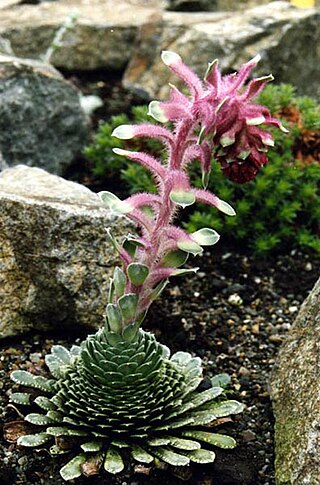
Saxifraga federici-augusti, common name Engleria saxifrage, is a herbaceous perennial plant belonging to the Saxifragaceae family. Its subspecies Saxifraga federici‑augusti subsp. grisebachii and the 'Wisley' cultivar of that subspecies have both gained the Royal Horticultural Society's Award of Garden Merit.

Coronilla valentina, the shrubby scorpion-vetch, scorpion vetch or bastard senna, is a species of flowering plant in the genus Coronilla of the legume family Fabaceae, native to the Mediterranean Basin, and introduced into Kenya and the United States. It is an evergreen shrub growing to 80 cm (31 in) tall and wide, with pea-like foliage and fragrant, brilliant yellow flowers in spring and summer, followed by slender pods. Linnaeus observed that the flowers, remarkably fragrant in the daytime, are almost scentless at night.

Genista sagittalis, called the arrow-jointed broom and winged broom, is a species of flowering plant in the genus Genista, native to central and southern Europe, Ukraine, and Anatolia. Its subspecies Genista sagittalis subsp. delphinensis, called rock broom, has gained the Royal Horticultural Society's Award of Garden Merit.
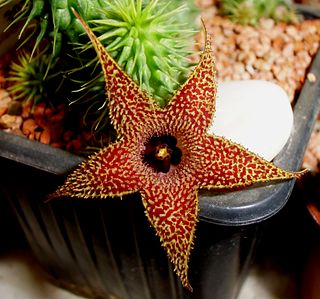
Huernia pillansii, called the cocklebur, is a species of flowering plant in the genus Huernia, native to the Cape Provinces of South Africa. A succulent, it has gained the Royal Horticultural Society's Award of Garden Merit as a hothouse ornamental.

Echinocereus scheeri is a species of hedgehog cactus in the family Cactaceae, native to northern Mexico. With its dramatic offsets, it has gained the Royal Horticultural Society's Award of Garden Merit.
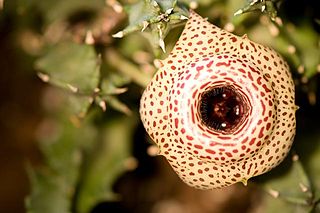
Huernia guttata is a species of flowering plant in the family Apocynaceae, native to the southern Cape Provinces of South Africa. A succulent, it has gained the Royal Horticultural Society's Award of Garden Merit.
Hoya lanceolata is a species of flowering plant in the family Apocynaceae. It is native to the Himalayas, Nepal, Assam, Bangladesh, Myanmar, south-central China, and Vietnam. Its subspecies, Hoya lanceolata subsp. bella, the beautiful wax plant, has gained the Royal Horticultural Society's Award of Garden Merit, but some authorities recognize it as its own species, Hoya bella.
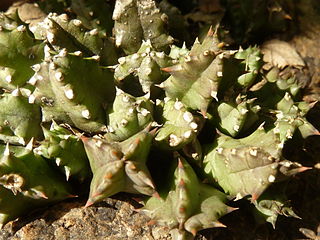
Huernia hystrix, the porcupine huernia, is a species of flowering plant in the family Apocynaceae, native to southeastern Africa. A succulent, it has gained the Royal Horticultural Society's Award of Garden Merit.
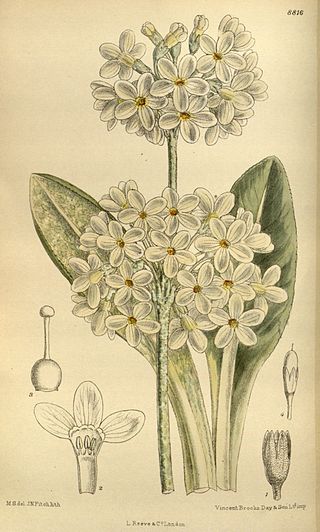
Primula chionantha, the snow-white primrose, is a species of flowering plant in the family Primulaceae, native to Tibet, Sichuan and Yunnan in China. It has gained the Royal Horticultural Society's Award of Garden Merit.
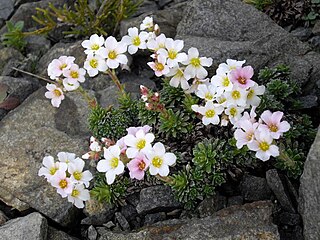
Saxifraga marginata, the Kabschia saxifrage, is a species of flowering plant in the family Saxifragaceae, native to southeastern Europe. It and its cultivar 'Balkan' have both gained the Royal Horticultural Society's Award of Garden Merit as ornamentals.
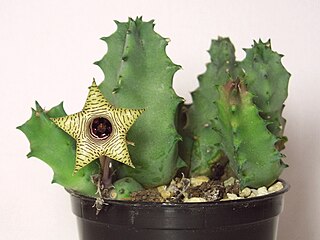
Huernia thuretii is a species of flowering plant in the family Apocynaceae, native to Namibia, and the Cape Provinces of South Africa. A succulent, as Huernia thurettii it has gained the Royal Horticultural Society's Award of Garden Merit.

Disocactus speciosus, the sun cactus, is a species of flowering plant in the family Cactaceae. It is native to Mexico, Honduras and Guatemala, and has been introduced to the Canary Islands. As its synonym Heliocereus speciosus it has gained the Royal Horticultural Society's Award of Garden Merit.
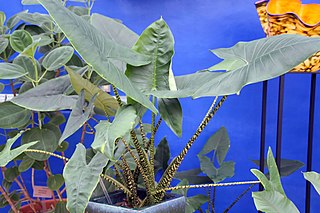
Alocasia zebrina, commonly known as the zebra plant or zebrina alocasia, is a plant in the family Araceae. It is endemic to the islands of Luzon, Mindanao, Leyte, Samar, Biliran, and Alabat in the Philippines. It is commonly grown as an ornamental plant worldwide. It is also locally known as gabing tigre in Tagalog. It is nationally listed as a threatened species and collection of A. zebrina from the wild is illegal in the Philippines.



















